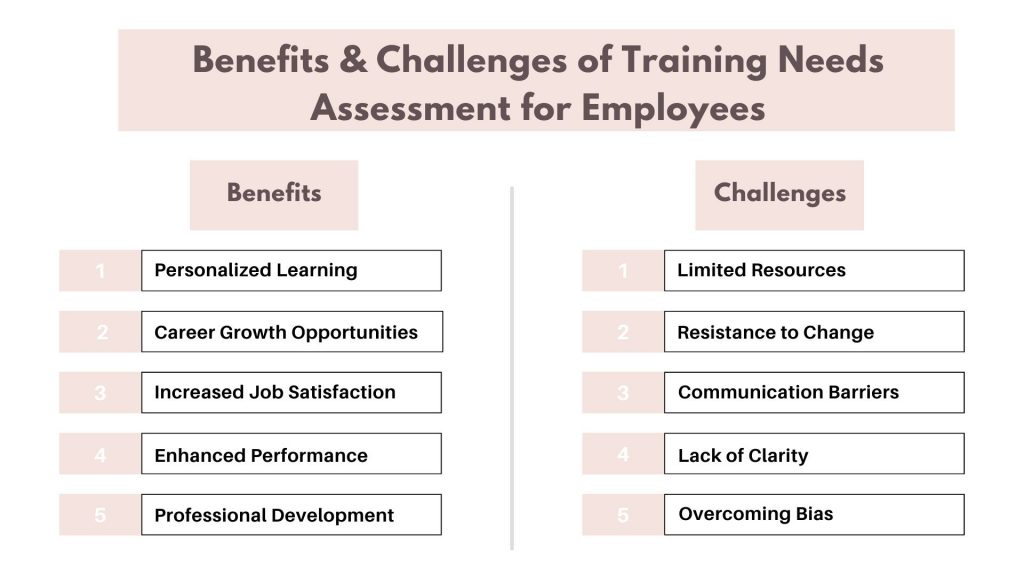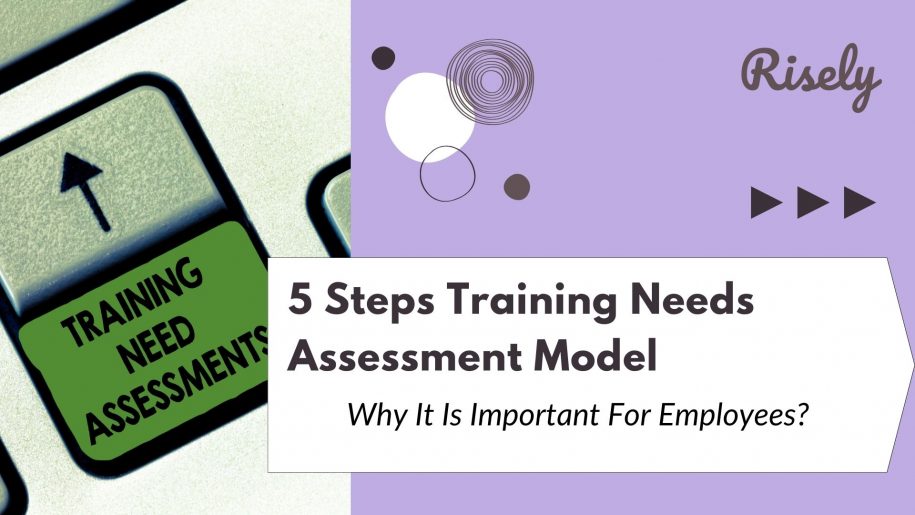5 Steps Training Needs Assessment Model: Why It Is Important For Employees?
Have you ever wondered why some training programs hit the bullseye while others miss the mark? Well, it’s all about understanding the unique needs of you and your team. In this blog, we’re diving into training needs assessment – a fancy term for figuring out what skills and knowledge will truly supercharge your professional journey. Imagine a tailor crafting a suit that fits you perfectly – that’s what a Training Needs Assessment does for your learning experience. So, buckle up as we unravel the 5 Steps Training Needs Assessment Model and explore why it’s the game-changer your career has been waiting for. Ready to have a better understanding of your learning? Let’s dive in.- 5 Steps Training Needs Assessment Model: Why It Is Important For Employees?
- Understanding Training Needs Assessment (TNA)
- Levels of Training Needs Assessment
- Why Should You Run a Training Needs Assessment for Employees?
- Challenges of Training Needs Assessment for Employees
- 5 Steps Training Needs Assessment Model
- Examples of Training Needs Assessment for Employees
- Training Needs Assessment for Employees
- Conclusion
- Other Related Blogs
Understanding Training Needs Assessment (TNA)
Training needs assessment is a systematic process that organizations undertake to identify the knowledge, skills, and competencies required by employees to perform their jobs effectively.
It involves evaluating the current capabilities of the workforce and determining the gaps between the desired and actual performance levels. The primary objective of training needs assessment is to identify the areas where employees require additional training or development opportunities, so that you can accurately fine tune your L&D strategy.Levels of Training Needs Assessment
Training needs assessments can be conducted at different organizational levels to address varying needs and objectives. Here are three common levels of training needs assessments:Organizational Level
At the organizational level, the focus is on identifying training needs that align with the strategic goals and objectives of the entire organization. This assessment considers the overall skills and competencies required to drive organizational success. It examines factors such as changes in the industry, emerging technologies, market trends, and future workforce needs. The assessment may involve analyzing workforce demographics, conducting gap analyses, and evaluating the organization’s current and future training requirements. The findings of this assessment help shape the organization’s training strategy and guide the development of high-level training programs.Department/Team Level
At the department or team level, the assessment zooms in on the specific training needs of a particular department or team. The focus is on understanding the team’s unique requirements and identifying skill gaps that may hinder their performance. This assessment involves conducting interviews, surveys, observations, and analyzing performance data. It aims to uncover the team’s specific training needs, such as technical skills, communication skills, leadership development, or project management. The findings help design targeted training programs that address the department’s or team’s specific needs, ultimately enhancing their effectiveness and efficiency.Individual Level
The individual-level training needs assessment focuses on the development needs of individual employees within the organization. It considers the skills, knowledge, and competencies required for employees to excel in their respective roles. This assessment involves performance evaluations, self-assessments, competency assessments, and feedback from supervisors and peers. It helps identify individual strengths and weaknesses, career aspirations, and areas for improvement. The findings guide the creation of personalized development plans, which may include specific training courses, coaching, mentoring, or job rotations. Conducting individual-level training needs assessments supports employee growth, engagement, and career progression. By conducting training needs assessments at these different levels, organizations can ensure that their training efforts are targeted, relevant, and tailored to the organization’s specific needs, departments, teams, and individuals. This comprehensive approach maximizes the impact of training initiatives and contributes to overall organizational success.Why Should You Run a Training Needs Assessment for Employees?
- Personalized Learning: Training needs assessments help tailor learning experiences to your needs, ensuring you receive the right skills and knowledge to excel in your role.
- Career Growth Opportunities: By identifying areas for improvement, you can actively pursue opportunities for growth and advancement within your organization.
- Increased Job Satisfaction: Training programs that address your development needs can boost your confidence and job satisfaction, making work more fulfilling.
- Enhanced Performance: Equipped with relevant training, you can perform your job more effectively and contribute meaningfully to your team and organization.
- Professional Development: Training needs assessments to pave the way for ongoing learning and development, empowering you to stay ahead in your field and adapt to evolving industry trends.

Challenges of Training Needs Assessment for Employees
- Limited Resources: Lack of resources, such as time and budget constraints, can hinder the implementation of comprehensive training needs assessments.
- Resistance to Change: Employees may be resistant to change or skeptical about the benefits of training, making it challenging to gain their buy-in and participation.
- Communication Barriers: Inadequate communication between employees and management can lead to misunderstandings or misinterpreting training needs and priorities.
- Lack of Clarity: Unclear objectives or expectations regarding training needs assessment processes can create confusion and uncertainty among employees.
- Overcoming Bias: Addressing biases or preconceived notions about training needs can be challenging, particularly if certain employees feel marginalized or overlooked.
Make identification of training needs easier with Risely’s free template!
Download Risely’s training needs analysis template and rejuvenate L&D at your workplace.
5 Steps Training Needs Assessment Model
The 5-Step Training Needs Assessment (TNA) Model is a commonly used training needs analysis model. This model provides a structured approach to conducting a comprehensive training needs analysis. Here are the five steps involved in the TNA model:- Identify the Purpose and Scope: In this initial step, clearly define the purpose of the training needs analysis and determine its scope. Identify the goals, objectives, and desired outcomes of the analysis. Consider the specific areas or departments within the organization that will be included in the analysis.
- Collect Data: Gather relevant data to assess the training needs. Data collection methods may include surveys, interviews, focus groups, observations, performance evaluations, and existing documentation. This step gathers information about current job requirements, performance gaps, skill deficiencies, and training preferences.
- Analyze Data: Analyze the collected data to identify patterns, trends, and areas where training is needed. Look for common themes, skill gaps, and training opportunities. Identify the priority areas that require immediate attention and determine the underlying causes of performance gaps.
- Determine Training Needs: Based on the data analysis, determine the specific training needs of individuals, teams, or departments. This involves identifying the skills, knowledge, and competencies that must be developed or improved to bridge the performance gaps. Prioritize the training needs based on their impact, urgency, and alignment with organizational goals.
- Develop Training Solutions: In this final step, develop training solutions to address the identified needs. This may involve creating training programs, workshops, e-learning modules, on-the-job training, or mentoring initiatives. Consider the most appropriate delivery methods, content, and resources to ensure effective and engaging training. Align the training solutions with the identified needs and the organization’s overall strategic objectives.
Other Interesting Reads
Examples of Training Needs Assessment for Employees
- Skill Gap Analysis: Conducting surveys or assessments to identify gaps in employees’ skills and competencies relative to job requirements.
- Performance Reviews: Reviewing employee performance data and feedback to pinpoint areas for improvement and development.
- Training Needs Surveys: Administering surveys or questionnaires to gather input from employees regarding their training preferences and areas of interest.
- Job Shadowing and Mentoring: Pairing employees with mentors or allowing them to shadow colleagues in different roles to identify learning opportunities.
- 360-Degree Feedback: Soliciting feedback from peers, supervisors, and direct reports to gain insight into areas where employees may benefit from additional training or support.
Training Needs Assessment for Employees
Training needs assessment for employees is a vital process that organizations undertake to identify and address the skill gaps and developmental requirements of their workforce. This assessment involves evaluating employees’ current competencies and performance levels to determine areas where additional training or development opportunities are needed. By conducting a thorough training needs assessment, organizations gain valuable insights into the specific training needs of their employees. This assessment can be carried out through various methods such as surveys, interviews, performance evaluations, and observations. The data collected during the assessment provides a foundation for identifying individual training needs, designing targeted training programs, and creating personalized development plans. Learn more in our guide to building effective L&D strategies:Conclusion
Conducting a thorough training needs assessment is essential for organizations to optimize employee performance and drive organizational growth. By identifying skill gaps and developmental needs through systematic analysis, organizations can design targeted training programs that align with individual and organizational objectives. Training needs assessment ensures that resources are allocated effectively, training interventions are relevant and impactful, and employees are equipped with the necessary competencies to succeed. Moreover, it promotes employee engagement, satisfaction, and retention. By prioritizing ongoing training needs assessment, organizations can adapt to changing demands, foster a culture of continuous learning, and position themselves for long-term success in today’s dynamic workplace.Make identification of training needs easier with Risely’s free template!
Download Risely’s training needs analysis template and rejuvenate L&D at your workplace.
Other Related Blogs
Building an Ultimate Leadership Development Action Plan
How to Build a Leadership Development Action Plan? Having a strong Leadership Development Action Plan is more critical than ever in today’s evolving business world. Whether you’re looking to drive…
Leadership Journey Examples on the RiseUp Radio Podcast
Leadership Journey Examples on the RiseUp Radio Podcast Leadership isn’t a destination – it’s a journey filled with twists, turns, and transformative moments that shape not just careers, but entire…
What is Immersive Learning? A New Era in Education
In this blog, you’ll learn what is immersive learning and how it is changing training, increasing engagement, and influencing the future of workforce development. … Read More
What are Learning Designs? All You Need To Know
This blog explains what learning designs are in depth while also covering it’s key components. It tells you about the process involved in creating a good learning design along with…


